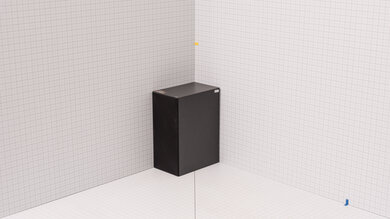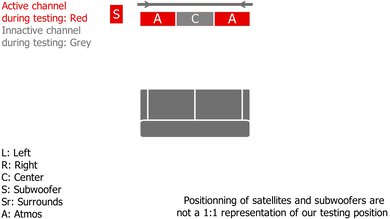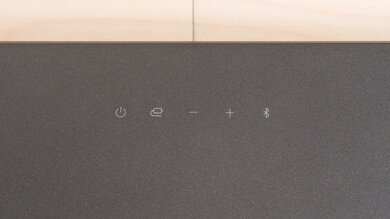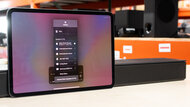The LG SPD7Y is a 3.1.2 setup released in 2021. It can get pretty loud, and it comes with lots of EQ presets to help you customize its sound. While it has a boomy sound profile on its 'Standard' preset, you can use its bass and treble adjustments to create a more neutral sound if you prefer. It also supports Dolby Atmos and surround content, though it doesn't offer a very immersive listening experience.
Our Verdict
The LG SPD7Y soundbar is satisfactory for mixed usage. Out-of-the-box, it has a boomy sound profile that can make your audio seem a bit muddy and dark. Fortunately, there are bass and treble adjustments to help you customize its sound more to your liking. It gets loud, and it also supports Dolby Atmos content. While it supports surround content, too, it has to downmix it to stereo, which doesn't sound as immersive.
-
Gets loud.
-
Bass and treble adjustments.
-
No graphic EQ.
-
Lacks some low-bass.
The LG SPD7Y soundbar is good for dialogue-centric content like TV shows. Thanks to its discrete center channel, it can accurately localize voices to a pinpoint location in the sound image. Its balanced mid-range can reproduce dialogue clearly, though it can also sound a bit muddy and dark. You can also use its dialogue enhancement feature to make voices more clear and crisp, or its auto-volume mode to balance the volume level across different programs.
-
Dialogue enhancement feature.
-
Bluetooth-enabled.
-
No Wi-Fi, AirPlay, or Chromecast built-in support.
The LG SPD7Y soundbar is satisfactory for music. On its 'Standard' preset, it has a boomy, bass-heavy sound profile that can make audio sound a bit muddy and dark. Fortunately, it comes with bass and treble adjustments that you can use to create a more neutral sound if you prefer. It also gets pretty loud, and there isn't a lot of compression when you push it to max volume, so audio reproduction is clean. However, it still struggles to reproduce an extended low-bass, so you don't feel the deep rumble in bass-heavy genres like EDM.
-
Gets loud.
-
Bass and treble adjustments.
-
No graphic EQ.
-
Lacks some low-bass.
The LG SPD7Y soundbar is decent for movies. It supports Dolby Atmos content, using its two up-firing drivers to bounce sound off the ceiling to create the illusion of height. It also supports surround content, but unfortunately, it has to downmix it into stereo to play it, which isn't as immersive. It also struggles to reproduce an extended low-bass, so you don't feel the deep rumble in action scenes and movie scores.
-
Gets loud.
-
Lacks some low-bass.
- 7.3 Mixed Usage
- 7.6 Dialogue/TV Shows
- 7.2 Music
- 7.2 Movies
Changelog
- Updated Dec 14, 2023: Added market comparison to the LG SP7R to the Style - Satellites box.
- Updated Aug 11, 2021: Review published.
- Updated Aug 05, 2021: Early access published.
- Updated Aug 02, 2021: Our testers have started testing this product.
- Updated Jul 29, 2021: The product has arrived in our lab, and our testers will start evaluating it soon.
Check Price
Differences Between Sizes And Variants
The LG SPD7Y soundbar comes in 'Black', and you can see the label for the model we tested here.
If you come across another version of this soundbar, please let us know in the discussion section below so we can update our review.
Compared To Other Soundbars
The LG SPD7Y soundbar is a mid-range 3.1.2 setup released in 2021. Unlike the LG SP7Y, it comes with two up-firing drivers for Dolby Atmos content. However, it lacks some more premium sound enhancement features, like AI Room Calibration or the 2021 LG TV AI Processor. It also has a boomy, dark sound profile out-of-the-box, which may not be ideal for all listeners. See also our recommendations for the best soundbars under $500, the best Dolby Atmos soundbars, and the best LG soundbars.
Depending on your listening habits, you may prefer either the LG SP7Y or the LG SPD7Y. The SP7Y is a 5.1 setup with a better soundstage that also offers a better surrounds performance. However, the SPD7Y comes with two up-firing speakers that support Dolby Atmos content, unlike the SP7Y.
The LG SP8YA is a better soundbar than the LG SPD7Y. The SP8YA has a more neutral sound profile out-of-the-box, and it also reproduces a more extended low-bass. It comes with more sound enhancement features, including room correction and some features that we don't test for like the LG AI TV Processor. It also supports more wireless playback options than the SPD7Y.
The Samsung HW-Q700A is a better 3.1.2 setup than the LG SPD7Y. The Samsung is better built and has better soundstage, surround, and Atmos performances. It supports more wireless playback options, and some users may prefer its more neutral default sound profile. It also has a graphic EQ for sound customization, unlike the LG.
The LG SP9YA is better than the LG SPD7Y. The SP9YA is a 5.1.2 setup that's better built. It has better soundstage and surround performances, and it can reproduce a more extended low-bass. There are even more sound enhancement features available, including room correction.
Depending on your listening habits, you may prefer either the LG SPD7Y or the LG SP7R. The main difference between these two setups is that the SP7R has rear speakers, while the SPD7Y doesn't. This means that the SP7R has a better surround sound performance. However, it doesn't support Dolby Atmos content like the SPD7Y.
The LG SPD7Y scores a bit better than the JBL Bar 5.1 Surround for mixed usage, but depending on your listening habits, you may prefer one over the other. The LG has a better soundstage, and unlike the JBL, it supports Dolby Atmos content. However, if you mostly watch surround content, you may prefer the JBL since it has a better surround performance. The JBL is also better-built with a more extended low-bass.
The LG SPD7Y is a bit better for mixed usage than the LG SL6Y. The SPD7Y is a 3.1.2 setup that supports Dolby Atmos content, unlike the SL6Y. You can also use its Full HDMI In port for video passthrough. That said, both bars have pretty similar performances overall.
The LG SN8YG is better than the LG SPD7Y. The SN8YG can reproduce a more extended low-bass, and it has better center and Atmos performances. There are more sound enhancement features available, including room correction and more wireless playback options. It even has built-in voice assistant support. While it gets as loud as the SPD7Y, unfortunately, there's some more compression present when you push it to max volume.
Depending on your listening habits, you may prefer either the Sony HT-G700 or the LG SPD7Y. The Sony is a 3.1 setup with better center and surround performances. Some listeners may also prefer its more neutral sound profile out-of-the-box. That said, the 3.1.2 LG comes with more sound enhancement features, including bass and treble adjustments. It also has a better stereo soundstage.
The Sonos Arc is a better soundbar than the LG SPD7Y. The standalone Sonos is better built and has better soundstage, center, surround, and Atmos performances. It also has a more neutral sound profile with its room correction feature, which some users may prefer. It also has built-in voice assistant support. However, the LG has EQ presets for sound customization and a Full HDMI In port.
The Samsung HW-Q70T is better than the LG SPD7Y. The Samsung is better-built with a graphic EQ. Some listeners may also prefer its more balanced sound profile out-of-the-box. That said, the LG has a better Atmos performance.
The Samsung HW-Q950A is better than the LG SPD7Y. The Samsung is an 11.1.4 setup with dedicated satellites. It has better soundstage, center, surround, and Atmos performances, and it can get louder. It also offers more sound enhancement features, like room correction, and more wireless playback options. Unlike the LG, it has built-in voice assistant support. Also, some users may prefer its more neutral sound profile out-of-the-box.
The Samsung HW-Q800A is a better 3.1.2 soundbar than the LG SPD7Y. The Samsung is better-built, with better soundstage, center, and surround performances. Out-of-the-box, it has a more neutral sound profile, and it reproduces a more extended low-bass. Also, it has a graphic EQ for sound customization and built-in voice assistant support. It supports more wireless playback options than the LG, too.
The Samsung HW-Q600A is a better soundbar than the LG SPD7Y. The Samsung is better built, and it has a better center channel performance. Unlike the LG, it comes with a graphic EQ for sound customization. Also, its default sound profile is more neutral, which some listeners may prefer.
Depending on your listening habits, you may prefer either the Samsung HW-A650 or the LG SPD7Y. The Samsung is a 3.1.2 setup that, unlike the LG, supports Dolby Atmos content. However, it doesn't reproduce quite as much low-bass as the LG, so you don't feel as much thump and rumble in bass-heavy music and action-packed movies. They're both decently versatile setups overall.
Depending on your listening habits, you may prefer either the Sonos Beam (Gen 2) or the LG SPD7Y. The Sonos is a small, compact bar with a 5.0 setup. It has better soundstage and surround performances and built-in voice assistant support. If you have a little more room in your space, the LG is still a decently versatile choice. It comes with a dedicated sub, and it reproduces more bass.
Test Results
The LG SPD7Y has a simple, sleek design that's similar to the LG SP8YA. It's mostly made of plastic, with two metal grilles protecting the up-firing speakers. The plastic on top of the bar has a matte finish, while the rest of the bar has a glossy finish.
The LG SPD7Y has a good build quality. The bar is mostly made of plastic, which feels solid and durable, and the metal grilles help protect the drivers inside. The sub is made of plastic and melamine, which also seems pretty durable. However, the fabric covering the front of the sub seems like it could rip or get dirty easily, which is a bit disappointing.
The LG SPD7Y has a decent stereo frequency response. On its 'Standard' preset, it has a boomy, bass-heavy sound profile. The bass range is overemphasized, and the treble range is underemphasized, so your audio can sound a bit muddy and dark. It also struggles to reproduce an extended low-bass, so you don't feel thump and rumble in action-packed movies. That said, the mid-range is pretty balanced, so vocals and lead instruments are reproduced clearly. There are also some bass and treble adjustments as well as some EQ presets to customize its sound if you prefer.
With calibration, the LG SPD7Y soundbar has a good stereo frequency response. It has a pretty neutral, balanced sound profile with its bass set to '-5' and its treble set to '3', which is suitable for listening to lots of different types of audio content. That said, it still doesn't reproduce a very extended low-bass, so you may not feel the deep thump and rumble in bass-heavy music or action-packed movies.
The LG SPD7Y has a decent stereo soundstage. The soundstage is perceived to be about as wide as the bar itself, but it doesn't have any tricks to make it seem wider than that. Its focus is good, so it's easy to follow sound objects like voices and footsteps, but it seems like a more general area is moving across the sound image rather than a pinpoint location.
The LG SPD7Y has a great stereo dynamics performance. It gets pretty loud, and there isn't a lot of compression when you push it to max volume, so audio reproduction is clean. As a result, it's suitable for listening to audio at loud volumes to fill up large rooms or crowded parties.
The LG SPD7Y has a satisfactory stereo THD performance. At normal listening volumes, it falls within good limits, so audio reproduction is clean and pure. That said, there's a jump in THD at max volume, especially in the bass to mid-range. This may not be very noticeable with real-life content, however.
The LG SPD7Y has a good center channel performance. Thanks to its discrete center channel, dialogue is accurately localized to a pinpoint location within the sound image. Its frequency response is a bit bass-heavy, but this shouldn't be too noticeable, since most voices are reproduced in the mid-to-treble ranges.
The LG SPD7Y has a poor surrounds performance. It has to downmix surround content into stereo to play it, so sound objects aren't as clearly or accurately localized within the sound image. Audio seems like it's coming from in front of you, rather than from speakers placed all around you. Also, its bass-heavy frequency response can muddy your audio and make it sound dark.
The LG SPD7Y has a disappointing height performance. It uses two up-firing drivers in the bar to bounce sound off the ceiling and back down towards you to create the illusion of height. However, this doesn't seem as real as the performance from discrete down-firing speakers found with home theater setups. Also, your audio can seem muddy and dark due to its bass-heavy frequency response.
The LG SPD7Y has a satisfactory selection of sound enhancement features. It comes with some EQ presets so you can customize its sound, including 'Standard', 'Bass Blast', 'AI Sound Pro', 'Cinema', 'Sports', 'Game', 'Clear Voice', and 'Music'. The 'Cinema' preset doubles as a virtual surround feature, which is advertised to help create a more immersive sound. Unfortunately, unlike the LG SP8YA, this soundbar lacks a room correction feature, so it may sound a bit different depending on the room you're listening in.
The LG SPD7Y comes with several inputs. There's a USB for files, so you can listen to audio from a thumb drive. The Full HDMI In port also lets you use the bar as a hub between different devices.
The LG SPD7Y supports all of the audio formats we test for via ARC. It supports Dolby Digital, the most common surround sound format, which is often found on Blu-ray discs and streaming platforms. Also, it supports more advanced lossless and object-based formats like Dolby Atmos and DTS:X.
The LG SPD7Y has fantastic audio format support via Full HDMI In. It supports common surround sound formats like Dolby Digital as well as lossless and object-based formats like Dolby Atmos.
This soundbar supports both DTS and Dolby Digital content, which are commonly found on Blu-ray discs and streaming platforms.
The LG SPD7Y has a good latency performance. It has fairly low latency with its ARC and Optical points. However, it has a slightly higher latency over its Full HDMI In port. As a result, it may not be suitable for watching videos, since your audio and your video may be out of sync. That said, some apps and TVs compensate for latency differently, so your real-world experience can vary.
You can wirelessly stream audio from your mobile device to the bar via Bluetooth. However, Apple and Google users may be disappointed that it doesn't support AirPlay or Chromecast built-in, unlike the LG SP8YA.
The LG SPD7Y can passthrough the highest quality bandwidth signals. If you connect the bar to your TV and your PC, text on the screen appears clear and crisp. It also supports Dolby Vision Passthrough, which is handy.
The LG Sound Bar app acts as a remote and lets you control all of the bar's settings. You can adjust the bass and treble or select different EQ presets. Also, you can cast files from a USB thumb drive. When a USB is plugged into the bar, a window pops up on the app that lets you see the list of songs on the drive.
Comments
LG SPD7Y: Main Discussion
Let us know why you want us to review the product here, or encourage others to vote for this product.
Update: Added market comparison to the LG SP7R to the Style - Satellites box.








































